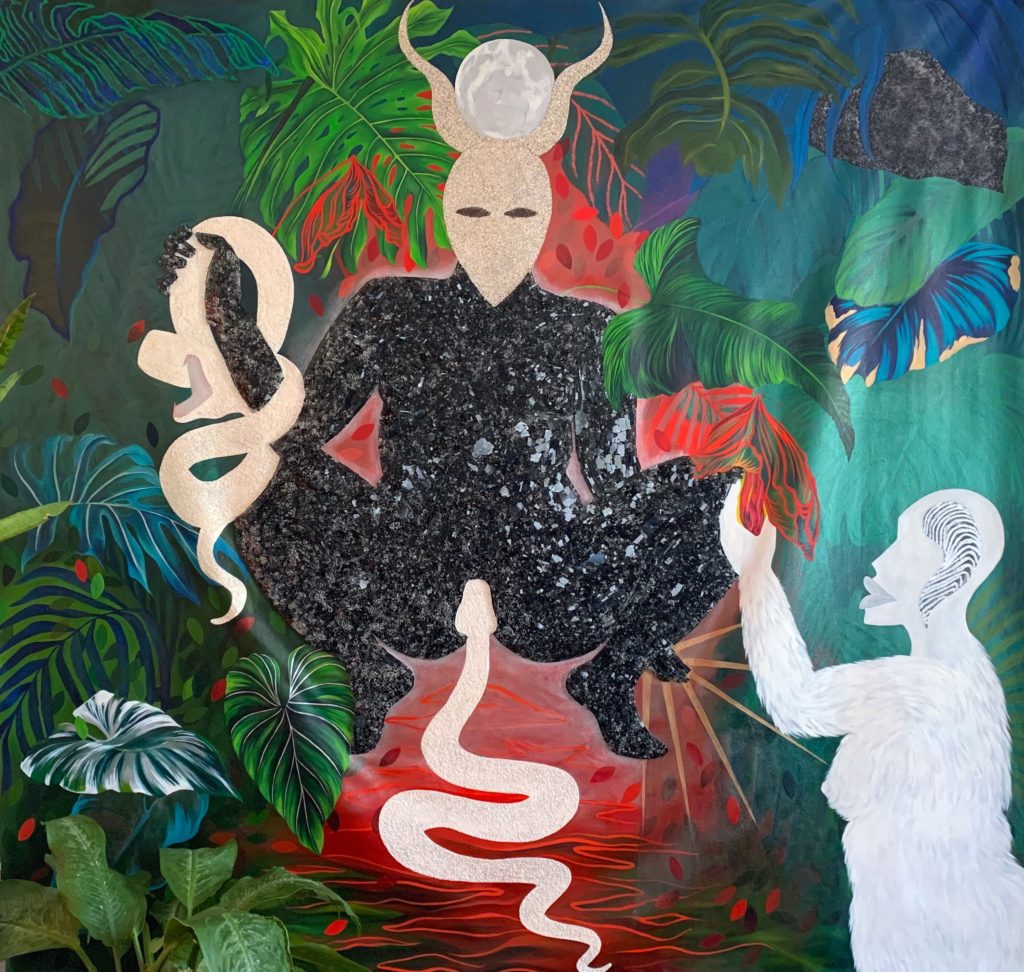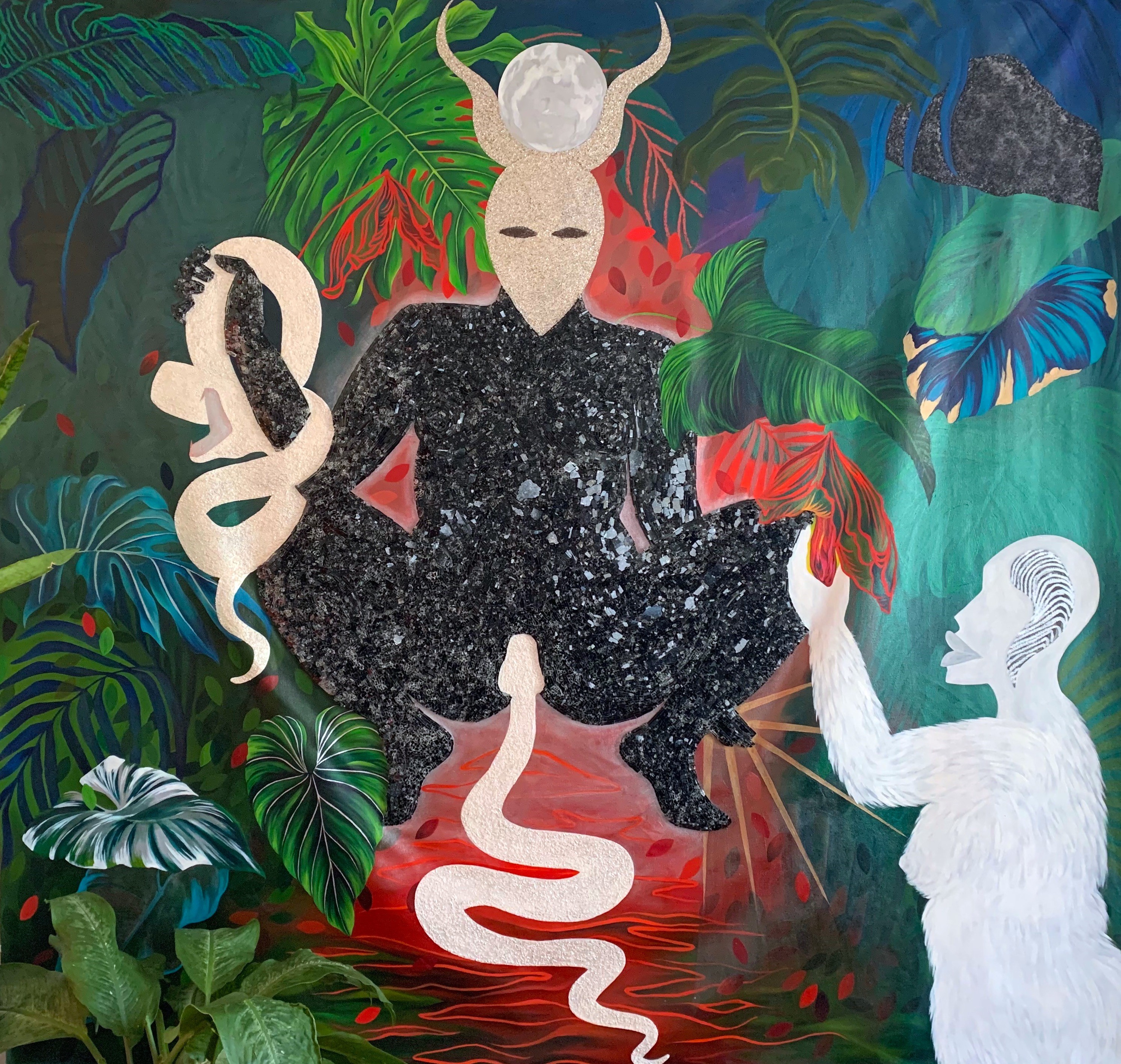
(Mahari Chabwera, Self Portrait of Nanu Buluku as Isis, In Eden, Calling the Earth to Witness, 2018. Oil, oil pastel, acrylic, and glass on canvas. Courtesy of the artist.)
By Betsy DiJulio
Juried art shows are peculiar animals. They are one person’s vision of what the viewing public needs to see from what was submitted, usually during an open call for entries, often with a fee, sometimes that includes a museum membership. In the case of MOCA’s 24th annual New Waves exhibition, all entrants were required to live in the Commonwealth and the vision is that of Carmen Hermo, Associate Curator for the Brooklyn Museum’s Elizabeth A. Sackler Center for Feminist Art.
Of the 363 artists who submitted work, she chose 29. Virginia Commonwealth University students and graduates faired well, as did local museum professionals—she chose the work of three—along with, I might add, my former students. Two were included, both male, and both for their photography.
The viewing public is never privy to what was submitted nor, typically, a given juror’s selection criteria. But it is fair to assume that jurors, in most cases, select what is to him or her the most interesting, compelling, or innovative work in a variety of media, sizes, and subjects and that will, when hung together, play nicely. Inevitably, some of the work selected—and selected for prizes—leaves us scratching our heads and wondering what exactly was in the juror’s mind. But such is the nature of juried shows.
Every juror comes with his or biases, and given Hermo’s position, one might assume that feminism would be one of them. While there are feminist-leaning pieces in the show, there is much more, installed by MOCA’s curator in such a was as to, indeed, create discourse. Of the pieces that skew feminist, Megan Wynne’s is one of the more evocative and layered. Her archival pigment print entitled “Impregnated,” from 2016, does exactly what she intends: uses her body in performative pieces staged in her home as a nexus for an exploration of the physical, emotional, and psychological dimensions of the maternal.
In this piece, Wynne sits perched on the edge of a bed, knees open, with one of her daughters kneeling between them, her dress stretched over the girl whose head reads as Wynne’s pregnant belly, her nose a protruding belly button. One of Wynne’s most effective pieces, the photograph speaks ambivalently of the mother-baby/mother-child relationship, the forced unity, detachment, and unbreakable bond—the merging and perhaps even suffocating—and the heavily laden questions of identity therein.
A text-based piece also addressing the notion of intertwined identities is Michaela Kane’s wool tapestry entitled “Self Reflection,” also from 2016. The beautiful neutralized colors of this 23 x 23” piece caught my eye from across the gallery, just after I had caught site of Benjamin Boshart, one of my exhibiting former students and an artist/museum professional in his own right. In response to my response, he perceptively commented, “It’s just enough.” And it is.
Block letters with the illusion of three dimensions spell the word “You,” but cast a long shadow—or, perhaps a reflection, of the word “Me,” calling into question the nature of our relationships with others, our identities in relation to theirs, and the psychological complexities of, again, the merging of individuals in relationships of all kinds.
Eva Rocha’s wood, plaster, and dish cloth sculpture entitled “Hymn to My Mother’s Tear at the Kitchen Table,” from 2018, is one of the more overtly emotional pieces exploring identity. With a vertically slatted based reminiscent of antique French mannequins, a torso pieced together from dishtowels, and a tone-on-tone face stitched onto muslin fabric, almost like a mask, the piece is a container for memories and emotions that coalesced during the artist’s return to her childhood home in Brazil where her mother still lives.
A troubling memory surrounding the teenaged Rocha’s three-day disappearance from which the artist has moved on, though her mother never has, clashed with the walls of a rotting, decomposing house, dishrags on nails, and images of triumphant, suffering saints. What emerged is this female figure whose faded, worn, material presence speaks silently of absence. And the silent, ringing hymn it sings is one of hardship, hollowness, long-suffering, and loss.
From identity to place, race, memory, and more, this show is sure to leave you with something to carry away.
WANT TO SEE?
New Waves 2019
Virginia Museum of Contemporary Art
Through August 18




